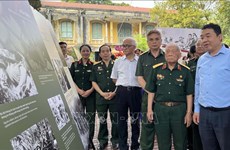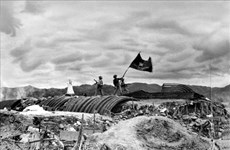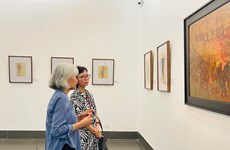Photo exhibition features time-honoured VN-France ties
A collection of 150 photos featuring the long relationship between Vietnam and France is on display in Hanoi.
A collection of 150 photos featuring the long relationship between Vietnam and France is on display in Hanoi.
The show, entitled “France-Vietnam-Four Centuries of Relations” provides a panorama of photos on 40 big panels with captions in both Vietnamese and French.
They reflect relations in trade, education, arts, science and technology from the late seventeenth century.
"The shared past of the two countries is much richer than we thought," said Pierre Geny, permanent secretary of l'Academie des Sciences d'Outre-Mer ( Academy of Overseas Sciences ) which helped produce the show.
The relationship began in December 1624 when French missionary Alex-andre Rhodes arrived in south Vietnam, and made great contributions to the creation of quoc ngu (romanised Vietnamese script) which is still used in Vietnam today. A part of the exhibition is devoted to him.
The relationship in the 18th century is linked to the activities of French horticulturalist Pierre Poivre, whose book. The Voyages of a Philosopher, showed his passion for Vietnam 's technique of mountain cultivated rice. The book was after read by many people, including Thomas Jefferson, third President of the United States.
A focus of the show, of course, is the colonial period from the end of the 19th century to the early 20th century. On display are portraits of eminent French and Vietnamese figures who contributed to the development of Vietnam.
They include August Pavie, who was very active in the science-technology field, Alexandre Yersin and Albert Calmet in the medicine industry, and Victor Tardieu and Nam Son, Nguyen Van Tho in the arts industry.
The resistance of Vietnamese people under the leadership of President Ho Chi Minh against the harsh rule of French colonialists is an important part of the show.
When the injuries of the past healed, bilaterial relations developed in all fields. Globalisation has brought the two countries closer, creating regional and international organisations in which both nations are members. This included the entry of Vietnam into the Francophonie world in 1997.
The show displays the work of the first French photographers in Vietnam, the first Vietnamese writers who wrote in French, French books talking about Vietnam - and portraits of French people with a deep love of Vietnam.
"Even though there has been much sadness, it would be silly of us to remember only those events," said Thi Minh Huong, head of the National Archives Centre.
Stephane Richemond, president of the Paris-based Images and Memories Association, said a stamp collection in memory of French doctor Alexandre Yersin (1863-1943), who founded the Medical School of Hanoi in 1902, will be distributed in Vietnam and France on September 20. This marks the 150th anniversary of his birth.
The exhibition will run until November 10 at the National Archives Centre, No 1, 18 Vu Pham Ham Street, Hanoi.-VNA
The show, entitled “France-Vietnam-Four Centuries of Relations” provides a panorama of photos on 40 big panels with captions in both Vietnamese and French.
They reflect relations in trade, education, arts, science and technology from the late seventeenth century.
"The shared past of the two countries is much richer than we thought," said Pierre Geny, permanent secretary of l'Academie des Sciences d'Outre-Mer ( Academy of Overseas Sciences ) which helped produce the show.
The relationship began in December 1624 when French missionary Alex-andre Rhodes arrived in south Vietnam, and made great contributions to the creation of quoc ngu (romanised Vietnamese script) which is still used in Vietnam today. A part of the exhibition is devoted to him.
The relationship in the 18th century is linked to the activities of French horticulturalist Pierre Poivre, whose book. The Voyages of a Philosopher, showed his passion for Vietnam 's technique of mountain cultivated rice. The book was after read by many people, including Thomas Jefferson, third President of the United States.
A focus of the show, of course, is the colonial period from the end of the 19th century to the early 20th century. On display are portraits of eminent French and Vietnamese figures who contributed to the development of Vietnam.
They include August Pavie, who was very active in the science-technology field, Alexandre Yersin and Albert Calmet in the medicine industry, and Victor Tardieu and Nam Son, Nguyen Van Tho in the arts industry.
The resistance of Vietnamese people under the leadership of President Ho Chi Minh against the harsh rule of French colonialists is an important part of the show.
When the injuries of the past healed, bilaterial relations developed in all fields. Globalisation has brought the two countries closer, creating regional and international organisations in which both nations are members. This included the entry of Vietnam into the Francophonie world in 1997.
The show displays the work of the first French photographers in Vietnam, the first Vietnamese writers who wrote in French, French books talking about Vietnam - and portraits of French people with a deep love of Vietnam.
"Even though there has been much sadness, it would be silly of us to remember only those events," said Thi Minh Huong, head of the National Archives Centre.
Stephane Richemond, president of the Paris-based Images and Memories Association, said a stamp collection in memory of French doctor Alexandre Yersin (1863-1943), who founded the Medical School of Hanoi in 1902, will be distributed in Vietnam and France on September 20. This marks the 150th anniversary of his birth.
The exhibition will run until November 10 at the National Archives Centre, No 1, 18 Vu Pham Ham Street, Hanoi.-VNA













